Learn how to make soft, silky sourdough pasta with this easy recipe- just 3 ingredients: flour, eggs, and sourdough starter (active or discard). Choose a quick 1-hour same-day dough or a 24-hour slow ferment for deeper flavor and digestibility. Perfect for pappardelle, ravioli, lasagna noodles and more. Step-by-step instructions and video below.
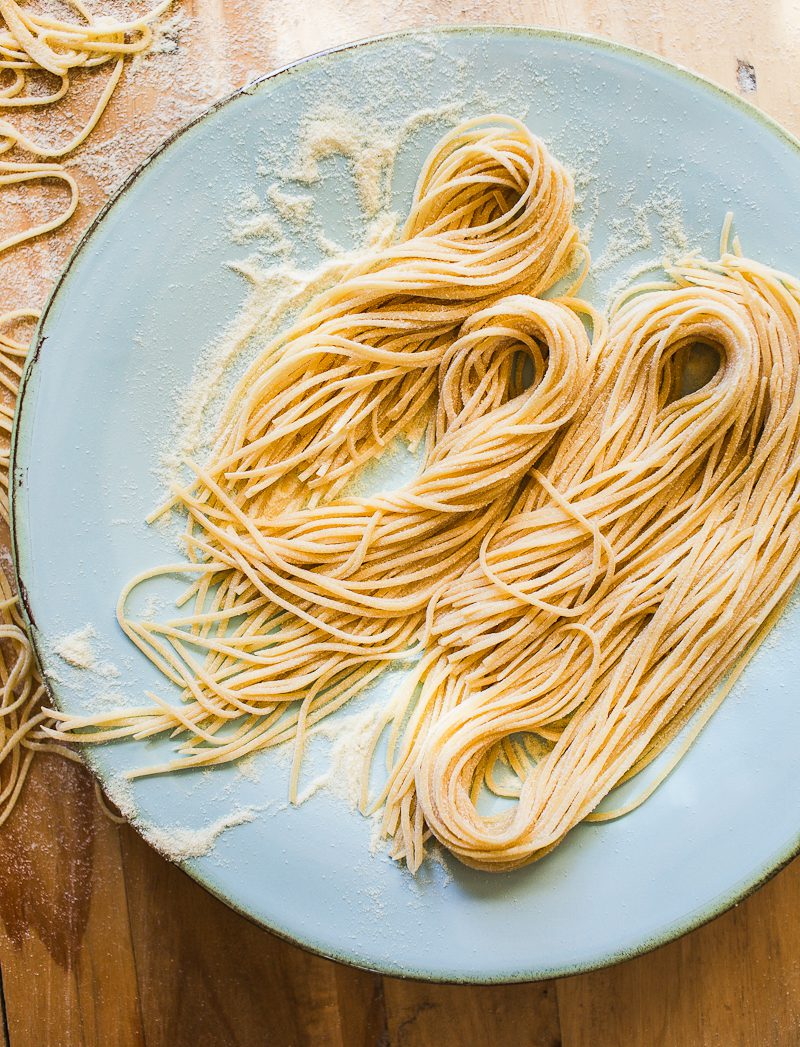
Sourdough pasta? Admittedly, I wasn’t into it because “sour” pasta sounds awful. Even tangy pasta sounds awful. But after enough people asked if my master homemade pasta recipe would work with sourdough, I thought: could it be done without compromising quality and taste?
Turns Out: It Works.
Three simple ingredients, that’s it. The texture? Soft and silky like traditional fresh pasta. The taste is subtle with a hint of complexity depending on the characteristics of your personal sourdough starter (some days, mine smells nutty like brown butter!). Toss it with a simple pomodoro sauce or even a rich Ragù Bolognese, and you’ll honestly surprise yourself. It’s that good.
Why Sourdough?
You can’t talk about sourdough- whether it’s bread, focaccia or pasta- without talking about fermentation. Given adequate time and temperature, the natural acids and friendly bacteria breaks down the hard-to-digest gluten enzymes making pasta easier to digest.
On a personal note: I’ve been making pasta the traditional way for years. Sourdough was a natural next step. Try it once and you’ll see: the end goal isn’t just to make pasta with a trendy title. The goal is the process– from feeding your starter, to feeling the dough, to twirling long spaghetti strands around your fork. It’s an invitation to explore.
Why This Recipe Works
- Practical ingredients: Works with Italian 00 or all-purpose flour
- Mixing options: Use a food processor, stand mixer, or make the dough by hand.
- Flexible timing: Choose between a 1-hour “same-day” dough or an overnight ferment for deeper flavor and digestibility.
- Semi-Dry Method: This technique prevents the pasta strands from sticking together (a common problem in pasta making).
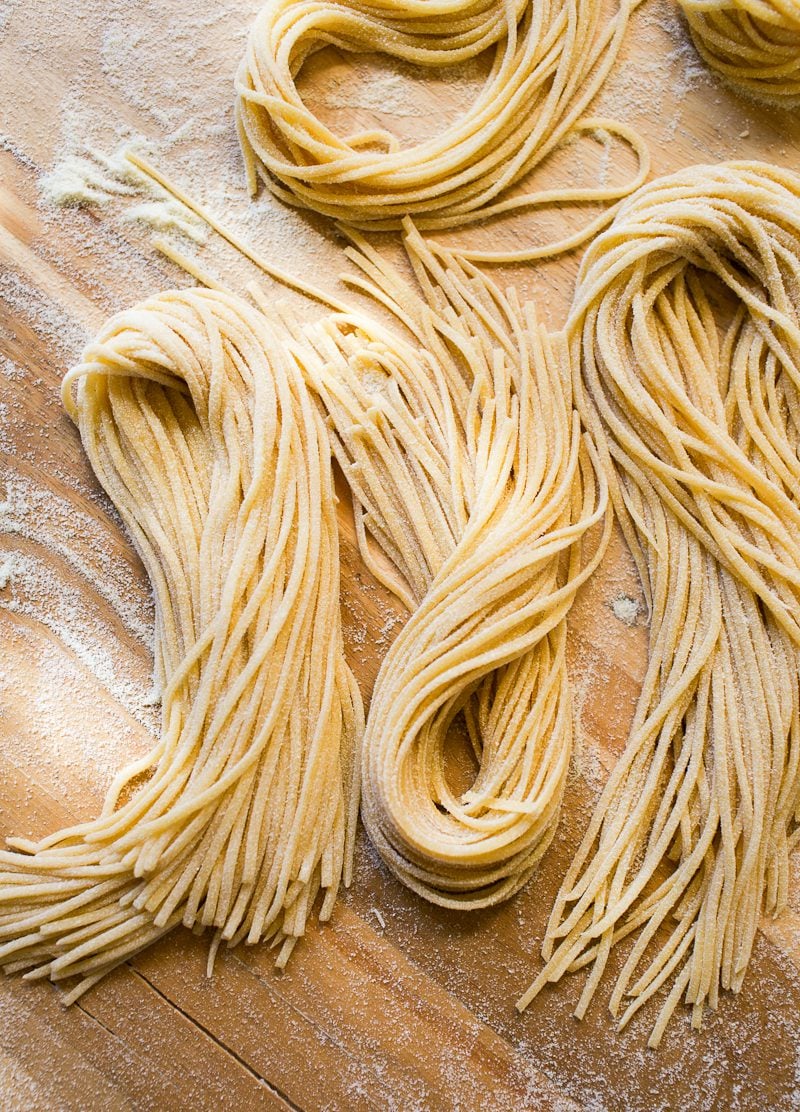
Ingredients You Will Need:
- Flour: Italian Tipo 00 is considered “the best” for homemade pasta. It’s a fine-milled, soft wheat flour that feels like baby powder. Try Molino Grassi or Caputo. Substitute with King Arthur all purpose flour for similar results.
- Eggs: Provide structure, hydration, and that rich, golden color.
- Sourdough Starter: Fresh, active starter is best. Discard can work if it’s recently fed and collapsed (not 3 months old sitting in the fridge- it’s too pungent and too sour).
- Olive Oil (optional): Not traditional, but convenient if your egg weight comes up short. For example, if you need 165 g of eggs, and you only have 160 g, don’t crack open another egg. Use 5 g of olive oil to make up the difference. It also makes the pasta dough easier to knead by hand.
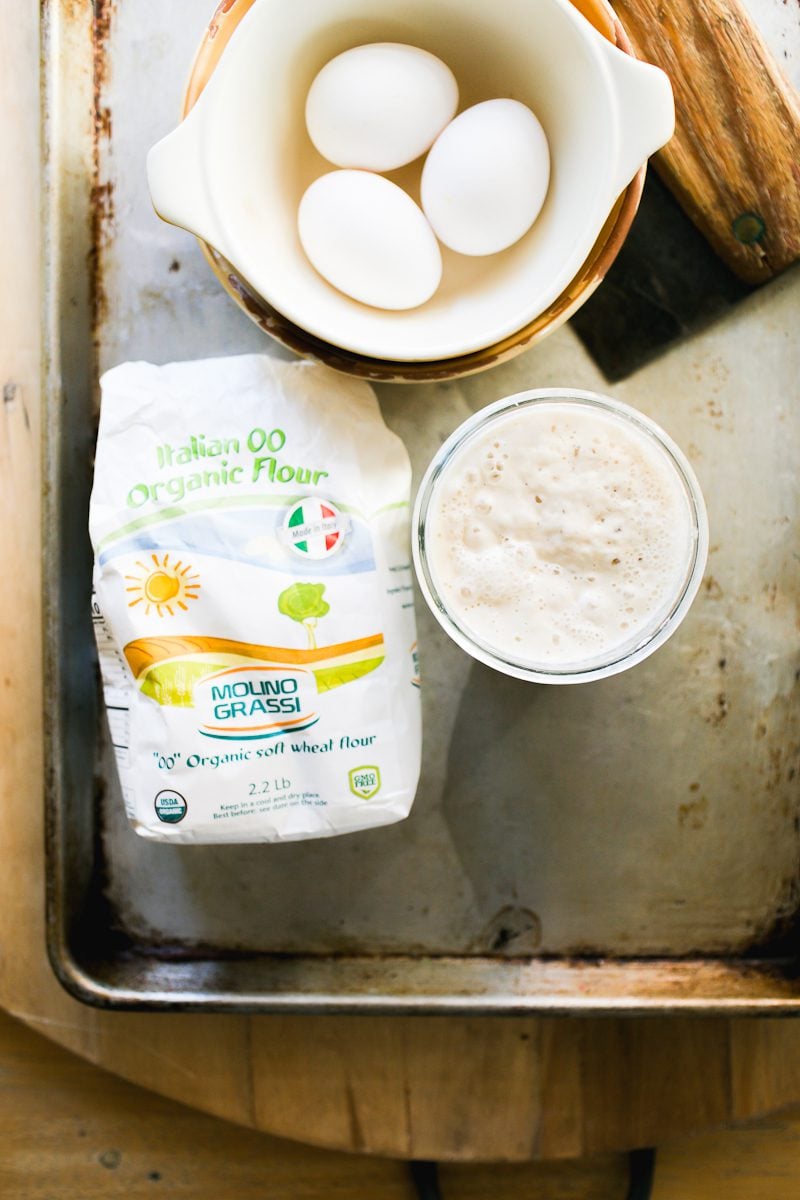
Before You Start: Quick Tips for Success
- Make space. Pasta sheets can measure up to 3 ft long! You’ll need a clutter-free work surface like a kitchen table or island to roll out the dough.
- Weigh everything (especially the eggs). When your amounts are exact, you’ll get a soft and pliable dough. Too little egg = dry, crumbly dough. Use this digital scale for accuracy. I don’t recommend measuring cups.
- Keep it covered. Pasta dough dries out quickly. Wrap in plastic wrap or cover with an upturned bowl at all times.
- Use active sourdough starter. You’ll get better flavor. Compared to sourdough discard (I’m generalizing here), the acidity levels are more balanced and fresh.
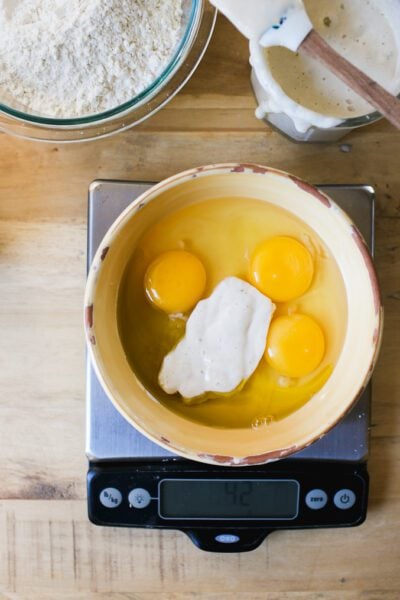
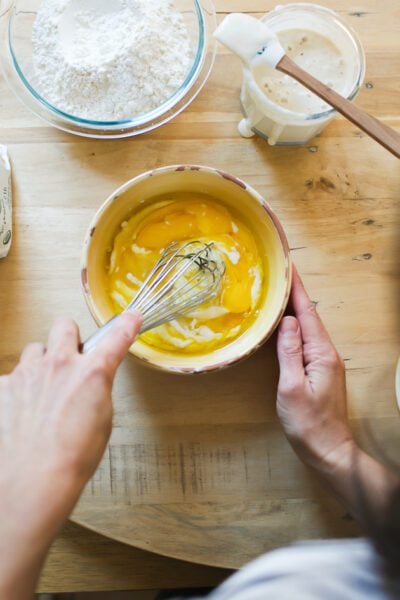
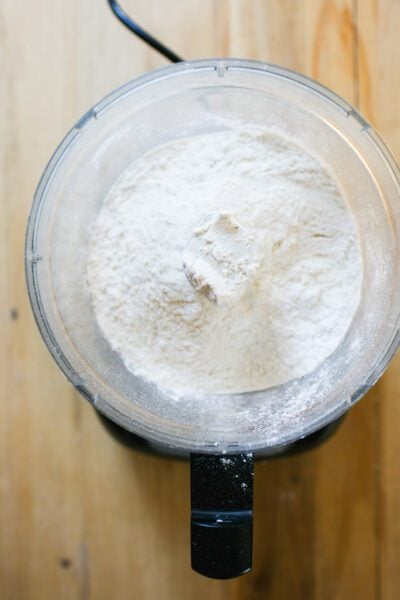
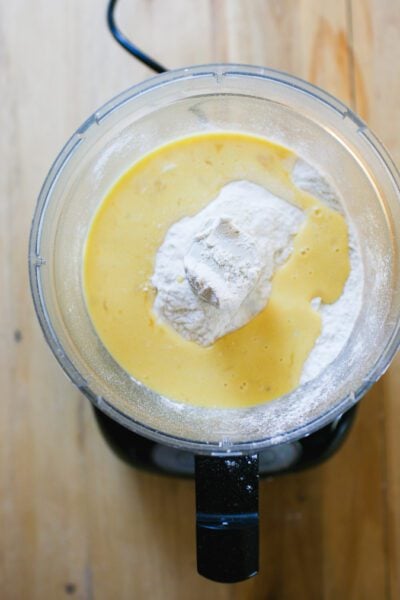
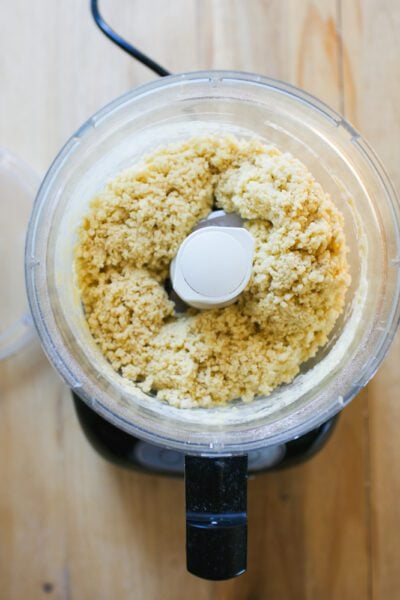
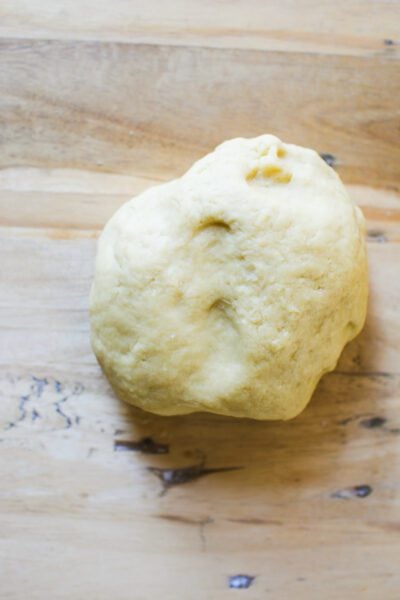
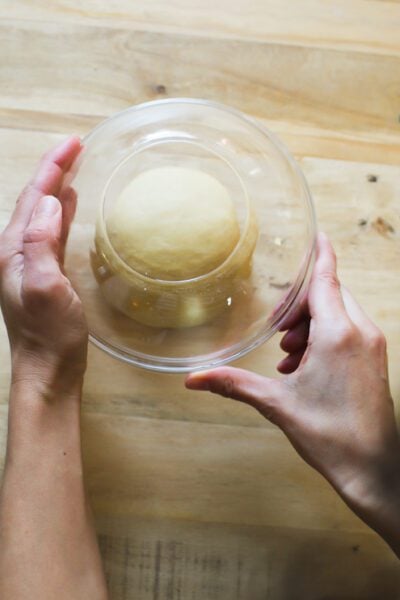
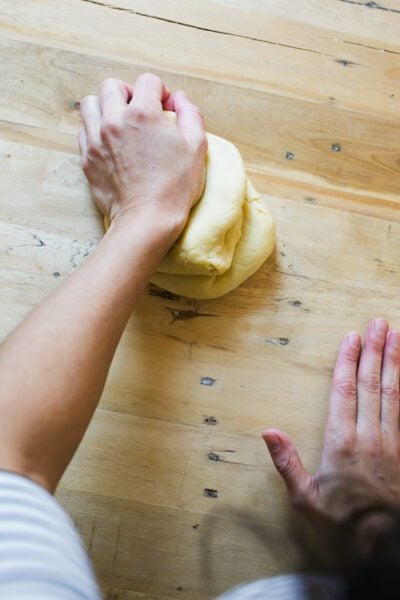
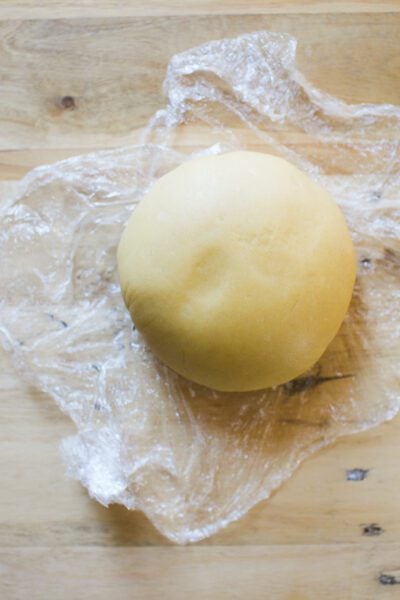
How To Make Sourdough Pasta {Step-By-Step Recipe}
Below, you’ll find easy instructions using a food processor to make the dough (fastest method) and a stand mixer with pasta attachments to roll and cut the pasta. You’ll have enough to feed 4 people, with storage tips and delicious pasta sauce pairing ideas. For a detailed, printable recipe: scroll to the end.
Step #1: Make The Dough
- To Start: Whisk your eggs and sourdough starter together.
- In a food processor: add the flour, egg mixture, and process until the dough comes together.
- Dump the dough onto your work surface and form into a rough ball- it doesn’t have to look perfect. Cover and rest for a few minutes.
- Knead the dough into a smooth and elastic ball (see video at 1:50 mark). It should feel soft, but not sticky. Wrap tightly in plastic wrap. Rest for 1 hour to overnight. Choose a fermentation option (see below).
How To Ferment Sourdough Pasta
- 1 Hour at Room Temperature (68- 75 F): This is the quickest method for those who want a simple “same day” sourdough pasta. Keep an eye on the dough as it rests; it will puff up slightly. The sourdough flavor is very mild.
- 24 Hour Overnight Option: Rest the dough at room temperature for 1-2 hours. Chill overnight, up to 24 hours (I’ve done up to 48 hrs. without the dough deteriorating). Make sure the dough is wrapped very tightly, double layer if you have to, because the dough will puff up. Note: chilled dough needs to rest for at least 30 minutes-1 hour before rolling. Otherwise it will be too stiff.
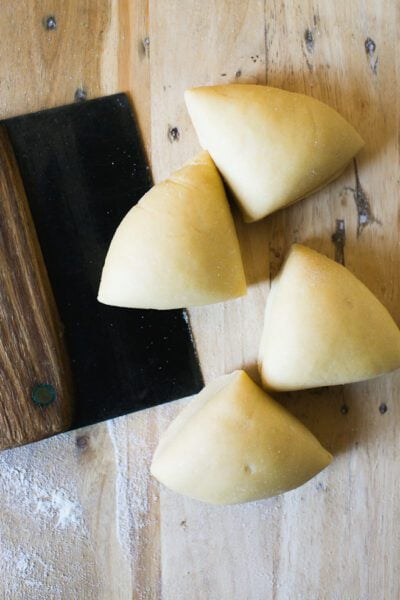
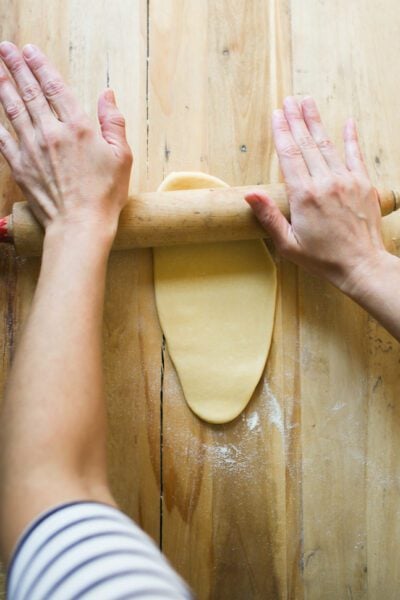
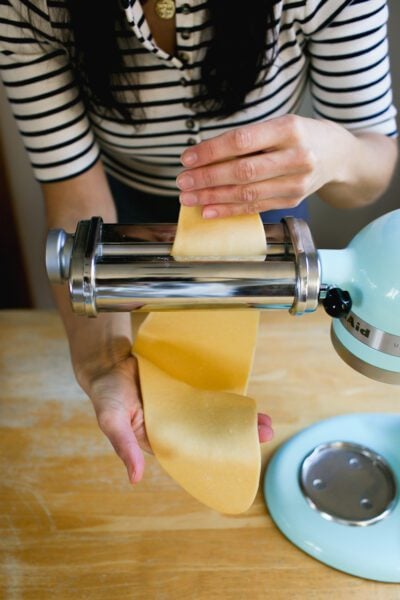
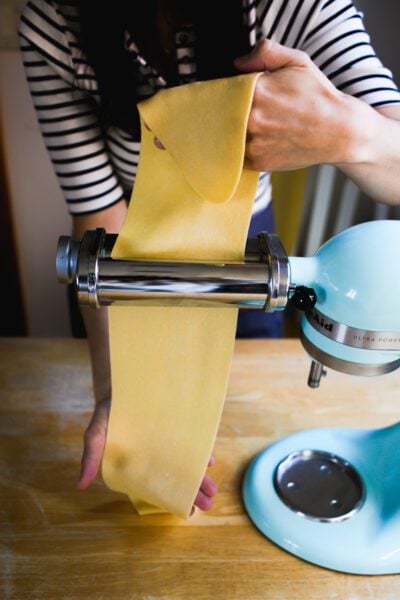
Step #2: Roll Into Sheets
- Dust your work surface, sheet pan, and pasta machine with semolina flour to prevent sticking.
- Cut the dough into 4 equal pieces. Flatten one piece into an oval disc. The goal is to get it thin enough to fit through the widest setting on your pasta machine- otherwise the dough will struggle and get smushed. Use a rolling pin.
- Send the disc through the pasta machine on the widest setting. This is “#1” on the Kitchen Aid attachment displayed above. Send it through a second time.
- Continue to roll the dough through settings #2-4 (2x on each setting) for spaghetti, fettuccine, pappardelle and tagliatelle. For homemade ravioli, the dough needs to be thinner- go up to #5. The pasta sheet is ready when it’s slightly translucent and you can see your hand underneath. When finished, fold and cover the pasta on your sheet pan.
Tip: If using a manual pasta machine, refer to their specific instructions for rolling the dough. The settings might vary, but the rolling process is the same.
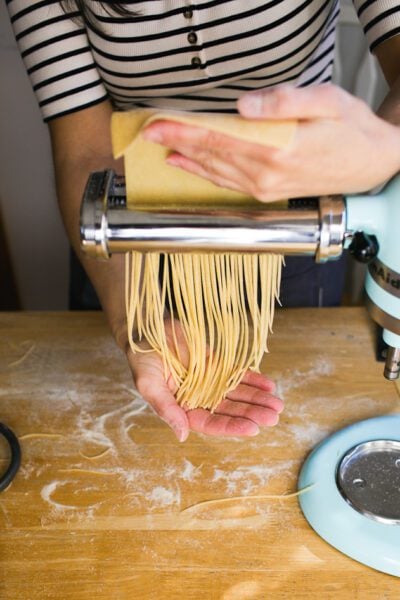
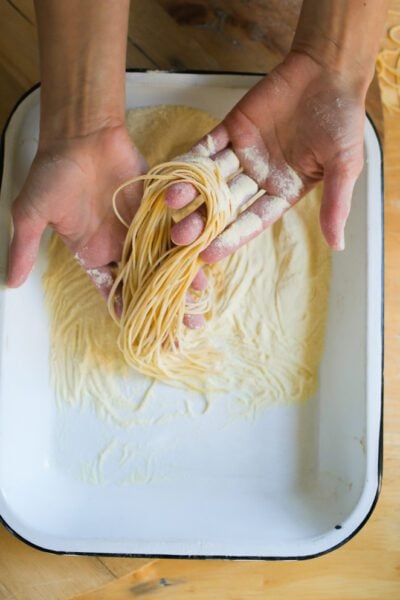
Step #3: Cut Sheets Into Pasta
- Before cutting, I like to semi-dry or “cure” the pasta sheets to slightly firm up the texture. This technique prevents the pasta strands from sticking together later on. Your pasta will look more sleek too, rather than soft and doughy- I can always spot the difference.
- To semi-dry: Hang the pasta sheets over the back of a chair, rod, or hanger for 5-15 minutes. Touch them with your hands occasionally; don’t let them dry out completely.
- Once lightly cured, cut the pasta using your preferred attachment or shape (I chose spaghetti). Toss the strands in semolina flour so they don’t stick and lay them out loosely on a tray.
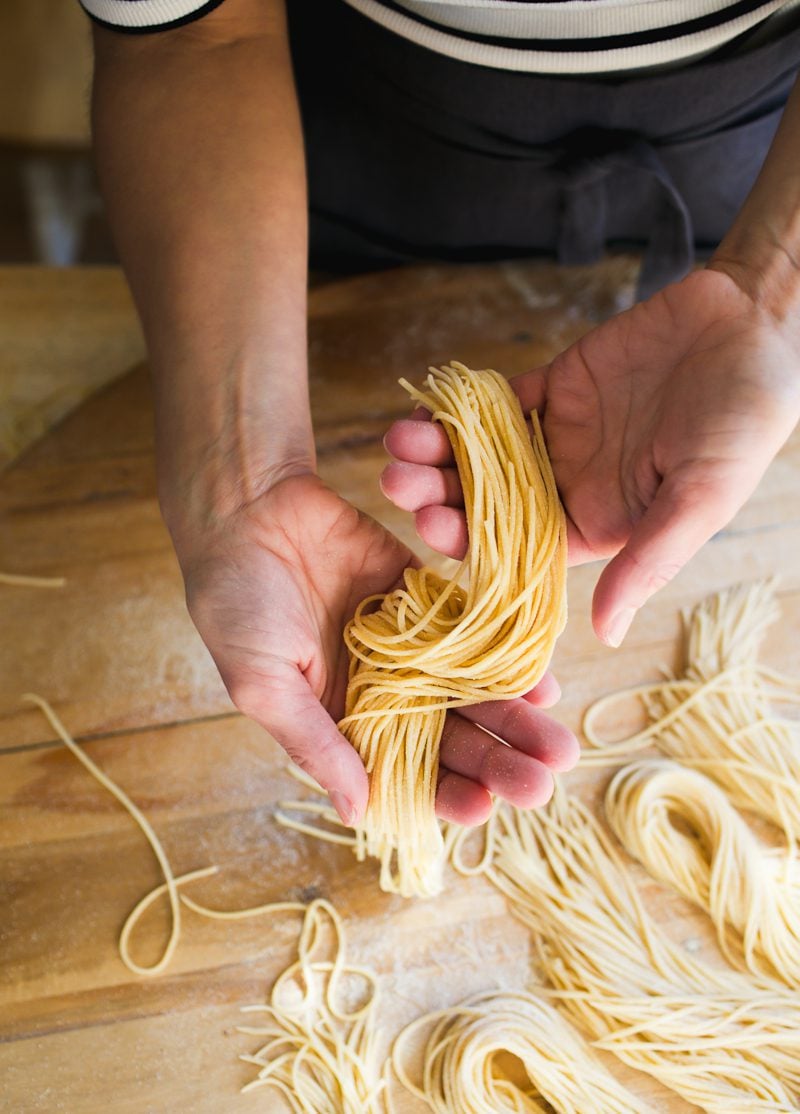
How to Store, Freeze & Cook Sourdough Pasta
To Store (Short Term):
Toss freshly cut pasta with semolina flour and place it on a sheet pan. Cover with plastic wrap, inverted sheet pan, or store in an airtight container. Leave at room temperature if cooking within 1–2 hours, or refrigerate for up to 12 hours. The flavor will continue to deepen when the cut noodles are chilled. Note: fresh pasta might oxidize and stick together if chilled past 24 hrs.
To Freeze:
Air-dry pasta for 15–20 minutes first (uncovered) to reduce sticking. Portion into zip-top bags and freeze for up to 1 month (any longer and it might dry out). No need to thaw; cook straight from frozen.
To Cook:
Bring 6 quarts of generously salted water to a boil. I don’t give exact amounts for the salt, because the flavor of salt varies considerably. Add the pasta and cook for 2–7 minutes, depending on the thickness. Always taste it. It should be al dente- tender with a slight bite. Use tongs to transfer pasta directly to your sauce.
Delicious Pasta Sauce Pairing Ideas
- Ragù Bolognese Sauce
- Authentic Pomodoro Sauce
- Real Alfredo Sauce (No cream)
- Classic Italian Basil Pesto (Pesto alla Genovese)
What’s Next?
- Beginner’s Guide to Fresh Homemade Ravioli
- Beginner’s Guide to Fresh Homemade Lasagna Noodles
- How to Make Perfect Pappardelle Pasta
By signing up, you agree to receive emails from The Clever Carrot. Unsubscribe at any time.
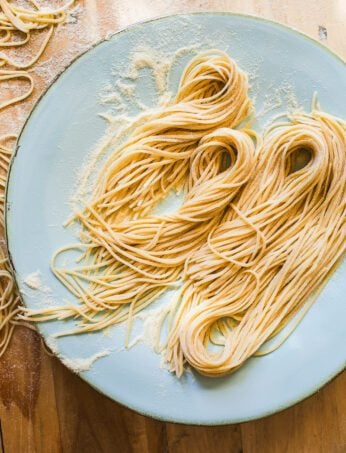
Best Sourdough Pasta {1-Hour or Overnight}
- Prep Time: 1 hour
- Total Time: 1 hour
- Yield: Serves 4–6 (500 g dough) 1x
- Category: Sourdough Discard Recipes
- Method: Boil
- Cuisine: Italian
Description
This sourdough pasta recipe requires only 3 ingredients: flour, eggs and active sourdough starter (or fresh sourdough discard). Please, do not use discard that’s 3 months old from the fridge! I’ve also included 2 pasta dough options: a same day “1 hour dough” and a longer, 24 hour fermented pasta to optimize sourdough’s natural digestibility. The dough can be made in a food processor, stand mixer or by hand (see all options below).
A few helpful tips:
- Make sure to weigh your ingredients, including the eggs to ensure the pasta dough is the correct texture.
- Use a food processor (if you have one) for speedy results (the dough comes together in 10-15 seconds).
- Use a hand-crank pasta machine or KitchenAid pasta attachments to easily roll out the dough.
- Don’t forget to watch the video!
Ingredients
- 300 g Tipo 00 or all purpose flour (I recommend King Arthur flour)
- 165 g eggs, cracked weight, about 3 large US eggs (*see notes)
- 40 g active sourdough starter or fresh sourdough discard
- Olive oil (*see notes)
- Semolina flour, for dusting
Instructions
Step #1: Make the Pasta Dough {Food Processor Method}
- Weigh the eggs (cracked) in a small bowl. If the weight is less than 165 g, use olive oil to make up the difference.
- Add the sourdough starter to the eggs; whisk thoroughly to combine.
- Add the flour to a food processor fitted with a metal blade. Add the egg mixture.
- Process the ingredients (no need to pulse) until a dough forms, about 10-15 seconds. If the dough doesn’t form into a ball, and looks “crumbly” it’s OK. Unplug the food processor and pinch the dough together; if it sticks, it’s fine.
- Remove the dough to your work surface. Form into a rough ball. Cover with an upturned bowl and let rest for 10 minutes before kneading. It will be easier to work with.
- After resting, knead the dough (see video at 1:50 mark). Do this by pushing the heel of your hand into the dough, and then turning the dough over itself. Repeat this technique several times, in a continued rocking motion, until a smooth ball forms, about 1-2 minutes. If the texture is sticky as you knead the dough, add a sprinkle of flour. When finished, wrap the dough very tightly in plastic wrap.
- Now the dough needs to rest. Choose a fermentation option: for a same day dough, rest at room temperature (68- 75 F) for 1 hour. Alternatively, to maximize fermentation and digestibility, rest at room temperature for 1-2 hours, and chill overnight, up to 24 hrs. Whichever option you choose, the dough must be wrapped tightly; it will rise slightly. Note: before rolling, chilled dough must rest for 30 minutes to 1 hour at room temperature. Otherwise, it will be too stiff.
Stand Mixer Instructions:
Whisk the eggs and sourdough starter together; set aside. Add the flour to the bowl of a stand mixer. Add the flour. Add the egg mixture. Mix with the dough hook until combined. Knead on speed #1 or #2, about 4-5 minutes. Form the dough into a ball and cover tightly with plastic wrap.
By Hand Instructions: (click here)
Step #2: Roll The Dough Into Pasta Sheets
- Set up your station: Dust your work surface, a sheet pan, and the pasta machine with semolina flour to prevent sticking.
- Cut the dough into 4 equal pieces; flatten one piece into a thin 6-8-inch oval disc (re-wrap the remaining pieces so they don’t dry out). Use a rolling pin.
- Send the disc through the roller on the lowest/widest setting. This is “#1” on the Kitchen Aid attachment displayed above. Now, send it through again. Note: if using a pasta machine, refer to their specific instructions for rolling the dough. The settings are different, but the rolling process is the same.
- Continue to roll the dough through settings #2-4 (2x on each setting) for spaghetti, fettuccine, pappardelle and tagliatelle. For homemade ravioli, the dough needs to be thinner- go up to #5. The higher the number, the thinner the dough will become. That’s the goal. The pasta sheet is ready when it’s slightly translucent and you can see your hand underneath.
- When finished, fold the pasta sheet in half, place onto a tray and cover.
- Repeat the rolling process for the remaining 3 pieces of dough.
Step #3: Cut Sheets Into Pasta
- Before cutting: I like to semi-dry or “cure” the pasta sheets ever so slightly. This gives the cut pasta strands a more firm and “leathery” finish, rather than a soft and doughy feel (this helps to prevent the strands from sticking together later on).
- To semi-dry: Hang the pasta sheets over the back of a chair or on a rod for about 5-15 minutes. Keep your eye on the time; you don’t want the sheets to dry out completely. Touch them occasionally. You will feel the difference in texture as time goes by.
- To cut: Take a pasta sheet and cut in half. Send it through the cutter attachment. I used the spaghetti shape above.
- Dust the pasta noodles liberally with semolina flour to prevent sticking- don’t skimp here. Arrange strands loosely on a tray.
- Repeat the cutting process for the remaining pasta sheets.
Notes
Here’s the deal with eggs: size varies. A large, US egg can weigh between 49- 55 g depending on the brand (and the chicken, obviously). The variance, which might seem nominal, is crucial. Pasta dough is not forgiving and can be too dry. So, I’ve taken out the guesswork and designed this recipe to go by total egg weight (not quantity). If 3 large eggs does not equal 165 g, add olive oil to make up the difference.
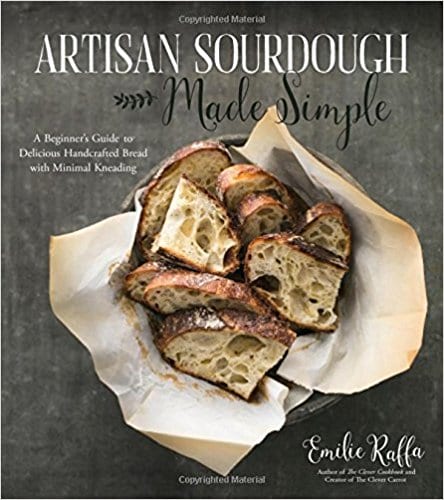


Comments
Reno says
Can I use all yolks?
Patrick O'Connor says
What hydration is your starter? Sorry if you mentioned this already.
Emilie Raffa says
Hi there! No worries! My starter is 100% hydration fed with bread flour.
Jan says
What size food processor do you suggest? I think mine will be too small (7 cup).
Meagan Heidelberg says
Made this today, and oh my goodness.. it was easy to follow and so amazing. I weighed everything as you said to do – I was off by maybe 2-4 grams on some things but it turned out perfectly. It was my first time using my kitchenaid mixer pasta maker and that was simple! Also my first time doing a food processor to mix the pasta dough. GAME CHANGER.
100% recommend
Margó says
Nagyon köszönöm a bemutatót!
Sokat tanulok Tőled! 🌹 Jó hogy rád találtam Emili! 🌹
Emilie Raffa says
You’re very welcome Margó (I just translated your comment 🥰). I always look forward to my comments and emails from you!
Rose says
Im a little bit confused if u make it in the stand mixer do u stillnlet it rest and then knead into a smooth dough? Mine is very dry even after I kneaded it. Weighed put my measurements
Maureen says
I made this (24 hr ferment) and it turned out amazing. I’m curious, can you dry fresh sourdough pasta for a longer shelflife, or is freezing the only long term option? Thanks for the great instruction!
My_okan.ca says
Thank you for the recipe :) I made fettuccini style with this recipe and it turned out delicious! I just had the first half with not much fridge time. Now the other half is in the fridge. I cannot wait to try them!
If anyone reading this is making fettuccini for the first time with a Remy Oliver pasta maker, I did 7 twice, 6 twice and 5 twice, and put the attachment to cut the pasta. :)
Helen says
Great recipe! Thank you!
Emilie Raffa says
Hi Helen! You’re very welcome. Glad you enjoyed it! 🥰
Aaron Ross says
Best noodles I’ve ever made….super easy to follow instructions.
Emilie Raffa says
This is so great to hear. Thanks for your feedback Aaron!
Angela says
I currently have my dough resting in the fridge until tomorrow, but I’m curious about what happened as I was kneading the dough. While it did get smooth and resembled a ball on the outside, on the bottom it was basically “layered”, if that makes sense. Not really a ball of dough but easily opened up to a flat sheet. What did I do wrong?
Celeste says
Hi! For everyone asking how to do this recipe with a pasta extruder (I used the Philips 7000), I added 250g of flour to the mixing compartment, and then slowly poured in my mixture of eggs and starter as the machine started mixing. I did two batches. The first I used 85g of the egg/starter mixture. It worked! But the noodle edges were a little rough, so for the next batch I added 100g of the starter/egg mixture and the noodles came out perfectly! For reference, I feed my starter using a 1:2:2 ratio. I hope that helps!
Sherwood says
I made this recipe yesterday, and it turned out beautifully. I did have to add OO to make up for missing egg grams, but the dough was easy to work with, and I had no problems. The resulting spaghetti was tender and delicious. I’m hooked! My only comment would be that when I swirled the spaghetti in the semolina, as shown in the video, the area I was holding on to did not get covered with semolina, causing the strands to stick. Fortunately, I discovered that in time and was able to separate them.
I have been baking with sourdough starter for a couple of years, and this is my first time using a starter with a 1:1:1 ratio. It’s caused me to research and understand why one recipe calls for a specific ratio vs another. I would be interested in other’s comments about this.
Tim says
I made two double batches on ny first attempt. I am not new to pasta making. It came out great. The only question I have is whether or not you have tried a pasta extruder? The recipe definitely needs modification for that purpose.
Dannyelle Doidge says
I have made this and wondered if it’s ok to leave in the fridge for longer than 24hrs?
Emilie Raffa says
Pasta dough will typically oxidize after 24 hours, but it’s not always the case. It really depends on the flour used and the condition of your sourdough starter. It’s worth experimenting to establish a reference point for comparison.
Demeter says
These were wonderful! Thank you!
Bex Fernandez says
If im making it for lasagna, how long would you recommend cooking the pasta for?
Emilie Raffa says
Hi Bex! For lasagna noodles, I blanch my pasta sheets for about 30+ seconds or so. Then, you have to shock them in cold water to stop the cooking process and lay flat on clean kitchen towels. I’ve written a detailed tutorial on how to make lasagna sheets {linked here}. The process is exactly the same if using sourdough pasta.
Jason says
Hi, thanks so much for the recipe. I am in the middle of the process right now.
I left the dough at room temperature for too long, and it expanded so far as too break the plastic wrap. I wrapped it back up and put it in the fridge. It’s now the next day and it hasn’t expanded anymore. Is it still alive?
Thank you
Emilie Raffa says
Yes, it’s fine. Totally fine. When you put sourdough anything into the fridge, fermentation will inevitably slow down (but it’s still alive). With sourdough pasta, you don’t necessarily need the dough to rise; you’re looking to either use it within a few hours to make pasta or rest overnight in the fridge. It really depends on your schedule. Hope this helps! PS: How did it turn out?
Jason Corazza says
Hi Emilie,
It came out wonderful, thanks so much.
It actually began to rise again when I took it out to bring to room temp.
The pasta was perfect. It handled and cooked so nicely. The best yet.
Thanks again.
Emilie Raffa says
Ahh, this is great to hear! Excellent. Glad it came out ok.
VirtualAmyk says
I realize your reply can’t come in time to help me, but for future, please do let us know.
I forgot to put my dough in the refrigerator after folllowing the stand mixer instructions (in my defense, it does not say to refrigerate at that point).
I plan to use my dough today. It has been sitting out for 8 hours. I will put it in the ‘fridge now, and then leave it out for an hour later? Maybe I will just leave it out since I’m going to roll it in a couple of hours?
What do you recommend?
Lea Heppner says
Can I make the dough and freeze it then make the pasta noodles later?
Emilie Raffa says
Hi Lea! I typically don’t freeze my pasta dough, just the noodles themselves. But you can do it. To do so: tightly wrap your ball of pasta dough in a few layers of plastic wrap (consider flattening the ball slightly so that it defrosts evenly). Freeze for up to 1 month. Let it thaw out in the fridge overnight before using. Then, allow it to sit at room temperature for 30 minutes to 1 hour before rolling.
Carla says
Hello. I’ve seen a few comments from people that have asked about the Philips Pasta machine which mixes and extrudes. Has anyone done the mixing as well as extruding? I would love to try this recipe but do not want to gunk up or jam up my machine. Appreciate any tips or information anyone might have as I would love to try the sourdough pasta.
Michelle says
I have your book from the library, going to have to buy it…too many great recipes I want to try!
Excited about this possibility too!I don’t have a food processor, can you give some basics like wet into dry, how long to mix it, etc? Thanks!
Emilie Raffa says
Thank you Michelle! You can absolutely do this by hand, not a problem. I recommend checking out my master fresh pasta dough recipe. There’s a Youtube video at the top of the post where I make the dough by hand in a bowl. There are also step-by-step pictures & instructions throughout the post with regards to texture, timing etc. To quickly summarize: pasta dough is soft and pliable (not sticky, wet or crumbly). It feels similar to play-doh.
Deb says
Would love an answer on this as well! Has anyone tried this? Thanks!
Lea says
If not using cut pasta can I let it dry and just use later like a week or two later
Emilie Raffa says
Yes. Comparatively speaking, the texture will be a tiny bit more firm once cooked, but absolutely still delicious. Also: dried (fresh) pasta tends to break and become brittle overtime. Consider freezing for longer storage use.
Sandra J Rattray says
Will these ratios (flour:egg:sourdough in grams) work with Einkorn (all purpose) flour? Thoughts or advice?
Many thanks.
Sandra
Emilie Raffa says
Great question. Add at least 25 g more flour if using Eikhorn, keeping everything else the same. After you mix the dough, and it has rested for 10 minutes, check the consistency again: if it’s too soft add a bit more flour as you begin to knead the dough.
Léa Heppner says
Tried this one. Beautiful results! My question now is can you freeze the dough and make noodles later? If so, what steps to follow?
Emilie Raffa says
I think you will have better results freezing the actual cut noodles vs. freezing the ball of pasta dough. You don’t have to wait for the dough to defrost first, and you can cook the noodles straight from frozen. Does that make sense? Hope this helps!
Lori says
Can you completely dry this pasta out and store it in the cupboard like store bought pasta? Or are your only options to cook right after making or to freeze?
I would love to make a big batch and store it for multiple meals in the cupboard.
Emilie Raffa says
Hi Lori! Freezing pasta is your best bet for long term storage. Comparatively speaking, fresh pasta that has been dried out at room temperature (and stored in the pantry) does in fact work, but it becomes dry and brittle over time. My best recommendation for you is to make multiple batches and freeze in airtight containers w/ parchment paper layers- not in zip top bags. This way your hard work won’t get crushed! Hope this helps.
Nava says
hi, thats looks great! I dont really understand though 😕…do I need to feed the discard sourdough before using for the pasta dough? like I do for bread? or do I use it as it is? because I have sourdough leftovers sometime from 2 weeks or more which usually I throw away eventually 🤭 so it comes to a point its not bubbling no more..if need to feed what ratio do I need to do? thank you 🙏
Emilie Raffa says
Hi there! I recommend using discard that’s in good condition. “Good condition” is defined as recently fed and collapsed sourdough starter (i.e. you’ll see frothy, foamy little bubbles on top) or leftover starter from another recipe. In both cases, it should smell pleasant and not be discolored. So, in the case of your 2 week old starter that you wanted to throw away? You were probably correct in not using it. You don’t have to feed your discard necessarily, it depends on your process and what stage you’re at. And again, if it’s in good condition or not.
Going forward, let’s start simple: feed your starter to make bread. Use what’s leftover to make pasta. In terms of feeding ratio for your starter, every baker does it differently. If you have a small starter I recommend 1:1:1. If you have a mother starter some bakers do 1:2:2 or more. Read this article for more helpful tips 👉🏻 https://www.theclevercarrot.com/2021/01/feeding-sourdough-starter-my-best-tips-tricks/
Gail Wells-Hess says
I’ve made this pasta many times and it never disappoints. Ever. Typically, egg pasta is used for any sheeted pasta and a flour and water only recipe is used shaped pastas. Well, one lazy day I used this recipe with semolina (that I ran through a stone grinder to get it a bit finer) and fermented it overnight. I changed my mind about what to make with the dough. I wanted cavatelli so I rolled it out to about a quarter inch, cut slices and ran them through my cavatelli maker. It worked perfectly and, as usual with this recipe, was delicious. This stuff rocks. Have fun with it!
Emilie Raffa says
Gail, this is such great feedback thank you! I love love love cavatelli (and love semolina). Do you mind if I ask what brand cavatelli maker you have?
Gail Wells-Hess says
Emilie, I’m sorry I didn’t see your question sooner. I have a CucinaPro. It was a thrifty choice on Amazon that works very well.
Donna Kirby says
I don’t have a pasta maker. Do I roll it out thinly, roll into a log and then slice it to form noodles? Probably like fettuccine.
Emilie Raffa says
Perfect! This works too. Thanks for sharing :)
Bobbi Tornheim says
I am trying all of the sourdough starter pasta recipes out there, and this one did not disappoint. The addition of a little EVOO was a nice touch. I served guests two different recipes after we had them help with the rolling and cutting, and they preferred your recipe – a little softer, probably from the olive oil. Thank you!!! We gluten sensitive people can eat pasta again!!
Emilie Raffa says
This is great to hear- thank you! The EVOO is a nice touch when used in small amounts. It makes the dough soft and supple to work with, and definitely easier to knead by hand. Glad you and your guests enjoyed the pasta!
Sarah says
I have some people that want some sourdough pasta.But I won’t be seeing them for a couple of days and I was wondering, you have instructions for semi drying,how do I fully dry out the pasta after cutting it into noodles so I can put it in a bag to take to them?
Emilie Raffa says
Hi Sarah! Fresh pasta dried out at room temp. is a little tricky, because it becomes dry and brittle overtime. Freezing is your best bet. But. If you want to experiment, hang dry your pasta strands (well coated in semolina or rice flour) on a pasta drying rack. This will take some time depending on temperature, bit it’s effective. Then portion the pasta into airtight containers (not bags- the pasta will break) separated by parchment paper, if necessary.
Bonnie says
Is there no salt in the pasta dough?
Emilie Raffa says
Correct. Salt is not a traditional ingredient in pasta dough. However, some recipes add some out of preference.
Needer says
I have been making regular pasta for year’s with my no fail recipe, I was really nervous to try a sourdough version, just because I’m new to sourdough but I am soooo glad I tried yours. It turned out EXCELLENT! I tried 3 different recipes and this is the ONE. I loved it so much I made it 4 times in one week. I tried drying them for the first time in my life and it’s much better to dry the pasta verses trying to freeze it. Maybe takes a bit more time but it’s so worth it. I store it in my cupboard then it doesn’t use up any of my freezer space with big bulky containers and no parchment paper needed. LOVE THIS RECIPE! Now this is my no fail recipe for sourdough 🥰 A huge thank you for sharing this with the world.
Emilie Raffa says
This makes me SO incredibly happy! Thanks so much for sharing your feedback and taking the time to comment :)
Christina says
I’m not going to lie, I was a little hesitant to make this. Not because I doubted this recipe, but because ever prior attempt to make homemade pasta has ended up with dense, sticky, globby noodles. I’m so glad I went for it, though. This was so yummy and so simple and easy! I’m so thrilled to finally have a go-to pasta recipe that will provide a healthy noodle option for my kids. Thank you!
Jay P says
Hello. I tried making this recipe and had an issue – I’m new to sourdough and baking really, but the dough never firmed up enough to cut. I tried to cut in into 4s and when I did it just smashed the dough down and made it stick to the counter – no clean cut. I’m not sure what happened. I used 3 eggs which equaled 150g so I used 15g of olive oil like instructed. Maybe too much oil? Any help would be appreciated.
Emilie Raffa says
Hi there! In your case, I think it’s your sourdough starter. Even though you weighed the correct amount, the texture might have been too runny which would make the dough more soft. Next time, just add more flour to adjust the consistency. FYI: water and oil hydrate flour differently, so you’ll get slightly different texture each time you make the dough, depending on how much of each ingredient you have used. As an alternative to olive oil, you can make up the weight difference with an egg yolk as well.
Jay P says
I will give that a try. Thank you so much.
-Jay P
Patti says
This is the best homemade pasta recipe I have tried. So good flavor wise and easy to handle. I didn’t end up with a ball of stuck together spaghetti. A new favorite for sure.
Emilie Raffa says
Thank you Patti! Glad you liked it! 🥰
Loredana says
Hi would this same recipe work with the KitchenAid extruder? (Ex. Rigatoni)
Emilie Raffa says
It does work, yes. However, if happens to be too soft or too sticky, knead in more flour if possible. Extruded pasta, as opposed to hand-cut pasta, typically uses a drier dough to push through the machine with ease.
Abbey says
AMAZING recipe! I’ve only done the 1-hour version since I can’t seem to think ahead, but my husband and I both agree it is some of the best pasta we’ve ever had. Even just kneading the dough I could tell it was going to be good!
Also, it is so easy! The easiest pasta recipe I’ve ever made. I’m even making it on weeknights.
Emilie Raffa says
Yay! This is so great to hear. Pasta is wildly therapeutic. And the dough has such a lovely, fun to work with texture. Thanks for sharing your feedback :)
Anastasia G. says
I have an overabundance of sourdough starter and fresh chicken eggs so I tried this recipe. Super easy. Super delicious. I’ll never buy fettuccine or spaghetti noodles again. Thanks for a fabulous recipe and video.
Emilie Raffa says
You’re very welcome! I bet this pasta tastes absolutely amazing with your farm fresh eggs. How fun. xx
Manon says
Miummm, prepared the dough yesterday and made and cooked pasta tonight ohhhh so good, will be make again for sure, thankssssss
Emilie Raffa says
You are very welcome! xx
Tina says
If you wanted to make a big batch can you freeze the noodles raw?
Emilie Raffa says
Yes, you can. However, fresh homemade pasta (of any kind) doesn’t do well in the freezer for a long time. It’s so delicate, it becomes brittle and can break easily. I would test a small batch first, and freeze for up to 1 month and see how you like it.
Aleta says
My 1st time making pasta and it came out wonderfully! Thanks Emilie.
Emilie Raffa says
You’re very welcome. Thanks for the feedback- so glad you enjoyed it!
Sandy says
I usually use Bob’s Red mill semolina flour to make regular egg noodles. May I substitute semolina one-to-one for your all-purpose flour? Would love to taste your noodles!
Eve says
Haven’t tried it yet but was wondering.. how to dehydrate and store them.? I dehydrate my eggnoodles (Spätzle) after cooking them. How would I go along doing these?
Briana Green says
The only pasta recipe I will ever use again!
Emilie Raffa says
Thanks so much for your feedback! This is so great to hear :) xx
Sheila says
It doesn’t say how much sourdough starter to use? Am I missing that?
Emilie Raffa says
Hi there! 40 g sourdough starter. It’s listed in the recipe above the comment section :)
Hannah Finley says
LOVE LOVE LOVE this recipe, it worked well for my kitchenaid attachment, I made spaghetti :)
Emilie Raffa says
Yay! I’m so thrilled. Thanks for your feedback Hannah!
Denise says
Not sure what I did wrong. My dough looked like a pile of rocks. I actually added five extra grams of sourdough starter by accident and thought it was gonna be too wet. Well, it was dry as anything I’ve ever seen and I make pasta dough for gnocchi and cavatelli a lot. I wanted to try sourdough to see how that went. . Everything out as suggested, and I did use my KitchenAid stand mixer and followed those directions, and it was a big crumbled mess. so dry so I added a teaspoon of olive oil, but that made no difference. Not sure what I did wrong. Maybe I’ll try it again you made it look so easy.
Emilie Raffa says
Hi Denise! We don’t want rocks ;) The dryness could be due to the thickness of your sourdough starter and/or a miscalculation of ingredients. Either way, the flour to liquid ratio of off. You weighed out all of your ingredients, correct? Including the eggs (cracked weight)? If the egg weight was correct, let’s look at your sourdough starter. What flour is it made of? Is the texture very runny or thick? Lastly, what brand of flour did you use for the pasta dough? Any additional info. you can provide would be really helpful. Thank you.
Denise Bullock says
My sourdough starter is made with unbleached all purpose flour, and it’s fed each time I use and once a week I add a quarter cup of rye flour mixed in. my sourdough starter is more on the liquidy side then on the batter side. I have been using this starter since . I do have to tell you this, I just could not find it in my heart to throw it away and I opted to put the dough into a plastic bag and let it sit in the refrigerator overnight and then got it out next day and let it get to room temperature. It was still very, very firm but softer than before and slightly manageable. I went through the whole process of rolling the pasta on each setting on kitchen aid. It was very difficult to press and roll, but I must tell you it was out of this world delicious. The pasta sheets had the rippled edge like you showed in your video right out of the press. I let them dry for about 30 minutes before cutting and I can’t tell you how perfect this pasta turned out. I just don’t know why it was so hard to work with and crumbly. I am going to try it again today and be very mindful that I’m weighing it correctly. I use double zero flour when I made it Saturday And will use double zero again. I’ll let you know how it turns out the second try!
Jiahui Cui says
Hi
Thank for the recipe!! It takes amazing. I’m wondering if you can help me with what to do if I want to add spinach to the recipe. How much more flour would I need to balance out the ratio? What is the ratio of flour to liquid that I would neeed? I made it with spinach and this recipe and it turned out to be too wet. Thanks so much!!
Emilie Raffa says
Hi there! Unfortunately, I haven’t tested it yet… so I don’t know the answer off the top of my head. I’ll update this post with a variation when I do :) In the meantime, for reference, you might want to check out my regular fresh spinach pasta dough (linked below).
https://www.theclevercarrot.com/2022/05/fresh-spinach-pasta-dough/
Lien says
Hi!
I am also having a hard time trying to find a sourdough pasta recipe that includes spinach. Is this not a thing? I already have a recipe for spinach pasta without the sourdough.
Thanks!
Stephanie says
Can this stay in the fridge for over 24 hours and still be good?
Emilie Raffa says
Yes. When ready to continue with the recipe, be sure to rest the cold dough at room temperature for 30 minutes- 1 hour before rolling. Otherwise it will be very stiff.
Tahsha Lundberg says
Hi there. Would this be OK in a pasta maker?
Tahsha
Emilie Raffa says
Yes. You should be able to adapt this recipe in a pasta maker.
Marrianne says
Hello Emilie,
I’m having great fun making sourdough pasta noodles!
My noodles fall apart easily when nearly dried and impossibly so when dried. I have measured everything with a scale and tried twice. The second time I kneaded them more by hand, but still, same result. (00 & semolina are lower in gluten of course.)
Is this why it’s recommended to freeze or store them in the refrigerator?
With thanks,
Marrianne
Emilie Raffa says
Hi Marrianne! This is very interesting. To clarify, a few questions: What shape pasta are you trying to dry? How thin are you rolling the pasta sheets (before cutting into pasta shapes)? And what method are you using to dry the pasta? I just want to make sure I have the correct visual. For storage, in the fridge is best (for up to 1 day). When frozen, the noodles actually become quite dry, brittle and break easily when stored for too long.
Marrianne says
Hi Emilie,
I am using half 00 and half semolina (both reputable Italian brands) to make my pasta dough.
I’m rolling the dough to almost translucent, but not quite, and I’m cutting them into pappardelle width noodles. I hang them on a plastic pasta drying rack.
Aside from them being brittle when fresh, once they are cooked, they are beautiful! They hold together well, and taste amazing! I haven’t frozen them, or even refrigerated them. I figured if store bought egg noodles are stored dry in plastic bags on shelves, I could do the same. 😉
Emilie Raffa says
Thanks for the info. You are doing everything right. I’m leaning towards pasta thickness & storage as the culprit. Too thin = too delicate. Next time, roll the dough out a little thicker if you prefer. Once dried, store flat in a shallow airtight container (no bag) so the ribbons stay protected. I hope this helps!
Sarah says
Hi there! This recipe is awesome! Simple and delicious. I was wondering if you’ve ever tried it with 100% whole wheat flour and if so do you need to change anything? Thanks!
Emilie Raffa says
This sounds wonderful! I haven’t tried 100% whole wheat yet. Please let me know if you experiment :)